CPU Scaling of Graphics Cards
In order to find out the dependency of various GPUs on fast CPUs, we took our Athlon 64 test bed and while keeping all variables the same, adjusted the clock speed from 1GHz all the way up to 2.6GHz. We ran two groups of cards across the entire spectrum of clock speeds in order to get CPU scaling curves on a per card basis.
The first group of cards were classified as "High End" cards and were all run at 1600 x 1200. All of the cards are graphed on the same graph as to help users determine at what CPU speed it makes sense to purchase a faster card.
The second group of cards were classified as "Mid Range" cards and were all run at 1280 x 1024. All of the cards are graphed on the same graph as to help users determine at what CPU speed it makes sense to purchase a faster card.
By no means were these charts meant to be all inclusive, but they should serve as a good guide for weighing CPU vs. GPU purchases. We also included a benchmark of Half Life 2 deathmatch in the results here using our own custom demo - at_mp_3.
All cards were run at the same high detail settings we performed our Half Life 2 GPU comparison under.
High End Graphics Card CPU Scaling
For our High End cards we’re looking at the Radeon X850 XT Platinum Edition, the Radeon X800 XT and Radeon X800 Pro from ATI. From NVIDIA we have the GeForce 6800 Ultra and GeForce 6800GT. We realize that this isn’t an all encompassing list of GPUs, but you should be able to extrapolate scaling of similar high end cards based on their performance relative to these five.
The most important graph is the first one as it is an average of all six of our Half Life 2 timedemos and gives you the best overall indication of CPU scaling of these GPUs on a holistic level. We have, however, included the individual charts for each timedemo for reference.
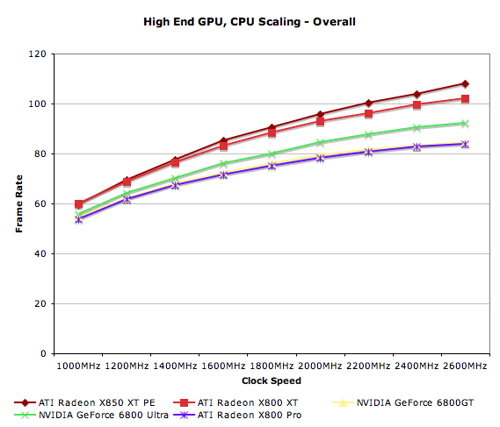
Interestingly enough, at 1600 x 1200, all of these high end GPUs scale quite similarly with CPU speed. We see that at lower speeds, the X850 XT PE performs identically to the X800 XT, it is only after you get above 2.2GHz on the Athlon 64 that the two even begin to separate. The same is not true for the GeForce 6800GT and Ultra, those two really begin separating much earlier on in the game.
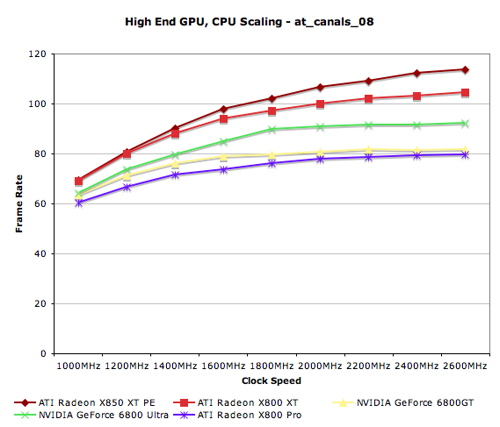
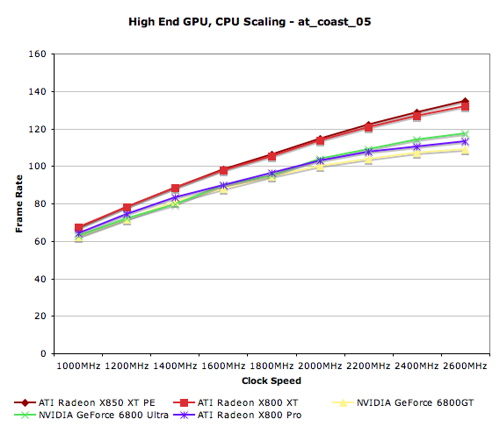
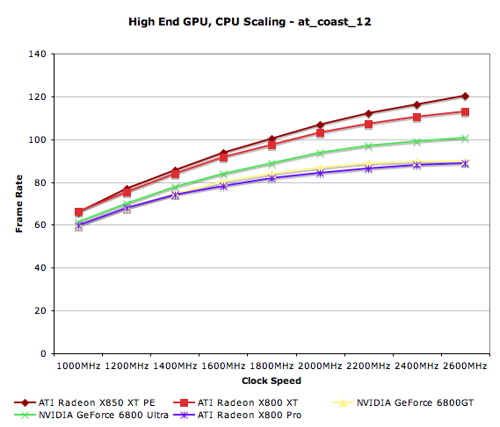
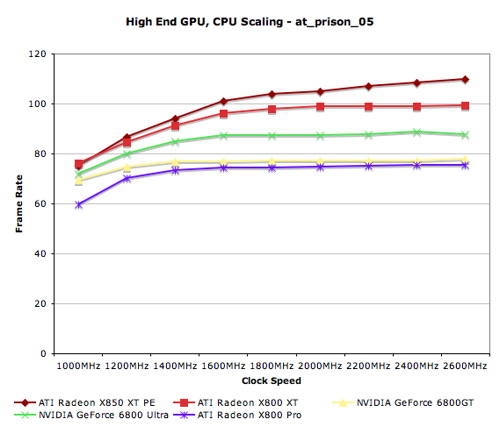
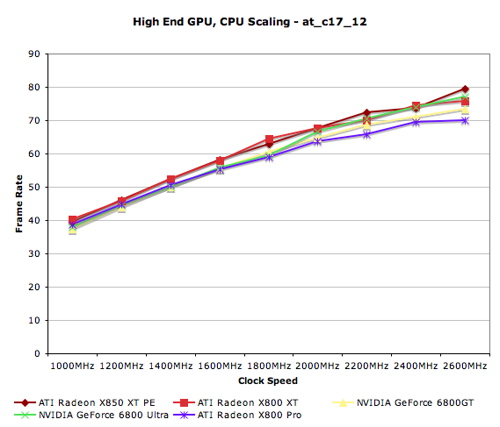











68 Comments
View All Comments
Phantronius - Wednesday, January 26, 2005 - link
If your gaming on a laptop, you need help.RockHydra11 - Wednesday, January 26, 2005 - link
Was anyone surprised by the results, or didn't know what the answer would be already? I could make a very educated guess before I even clicked on the link.T8000 - Wednesday, January 26, 2005 - link
This kind of CPU reviewing really makes me wonder if anyone plays with a $700 R850 XT-PE without anti-aliasing, anistrophic filtering and does so at 1280x1024.I mean, if that's all you want, why not save a cool $500 and buy a GF6600GT instead.
It would be nice if someone reviewed CPU scaling at real gaming settings, because the 20% differences created here, may translate in only 5% with real settings, making it unnoticable during gameplay.
Whiskyboy - Wednesday, January 26, 2005 - link
I thought the artilce was a nice return to the feature for feature comparison that a shopper like myself really finds useful. I'm slighlty curious about upcoming technologies but I'm really disintereted in seeing how the brand new toy from AMD or Nvidia performs because I'm not going to suggest paying the ridiculous premiums they charge for the new junk. Seeing the effect that things like memory timings, bandwidth, cpu clock have on performance in a consistent platform make it easier for me to make recommendations to my customers for their systems. I like the Buyer's Guide articles, but in all honesty I want the charts that this article has. If you are suggesting that there should be more articles like this, I agree, but I'm not about to complain about the first article in months that actually made a useful shopper's comparison. Thanks AnandMarlowe - Wednesday, January 26, 2005 - link
I would like to see the cpu scaling done with Intel cpu's too! :)Cybercat - Wednesday, January 26, 2005 - link
The X850XT PE being a PCIe part, how did you use it on Socket 754 CPUs? I've not seen any Socket 754 NF4 boards yet.Aquila76 - Wednesday, January 26, 2005 - link
#32 - Gamers buy PC's in orders of magnitude greater numbers than laptops. Maybe you can run Half-life 2 on your Intel Extreme Graphics, but that's nothing compared to gaming on an A64 with a decent video card and sound.jherber - Wednesday, January 26, 2005 - link
where is the pentium m? MOST OF US BUY LAPTOPS THESE DAYS.REMF - Wednesday, January 26, 2005 - link
roflmao:http://images.anandtech.com/graphs/half%20life%202...
an Athlon64 3200+ @ 2.0GHz gets 112fps
an Athlon64 3000+ @ 1.8GHz gets 104fps
.'. an A64 3100+ @ 1.9GHz would get 108fps
...... the same as a P4 570 running at 3.8GHz, twice the speed!
LOL
bupkus - Wednesday, January 26, 2005 - link
I'm glad to finally see this article. I've been waiting for weeks and beginning to think this article was just "vaporware". ;)As to the following quote:
"If you are stuck with one of those older but still well-performing GPUs, don't bother upgrading your CPU unless it's something slower than a 2.4GHz Pentium 4 - you'd be much better served by waiting and upgrading to dual core later on."
As this was just a tantalizing morsel of things to come, I'm looking forward to the coming weeks.